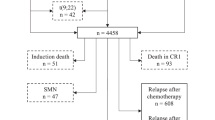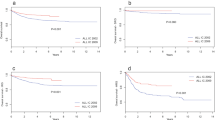Abstract
The long-term outcome of 1390 children with acute lymphoblastic leukemia (ALL), treated in two successive clinical trials (Taiwan Pediatric Oncology Group (TPOG)-ALL-97 and TPOG-ALL-2002) between 1997 and 2007, is reported. The event-free survival improved significantly (P=0.0004) over this period, 69.3±1.9% in 1997–2001 to 77.4±1.7% in 2002–2007. A randomized trial in TPOG-97 testing L-asparaginase versus epidoxorubicin in combination with vincristine and prednisolone for remission induction in standard-risk (SR; low-risk) patients yielded similar outcomes. Another randomized trial, in TPOG-2002, showed that for SR patients, two reinduction courses did not improve long-term outcome over one course. Decreasing use of prophylactic cranial irradiation in the period 1997–2008 was not associated with increased rates of CNS relapse, prompting complete omission of prophylactic cranial irradiation from TPOG protocols, beginning in 2009. Decreased use of etoposide and cranial irradiation likely contributed to the low incidence of second cancers. High-risk B-lineage ALL, T-cell, CD10 negativity, t(9;22), infant, and higher leukocyte count were consistently adverse factors, whereas hyperdiploidy >50 was a consistently favorable factor. Higher leukocyte count and t(9;22) retained prognostic significance in both TPOG-97 and TPOG-2002 by multivariate analysis. Although long-term outcome in TPOG clinical trials is comparable with results being reported worldwide, the persistent strength of certain prognostic variables and the lower frequencies of favorable outcome predictors, such as ETV6-RUNX1 and hyperdiploidy >50, in Taiwanese children warrant renewed effort to cure a higher proportion of patients while preserving their quality of life.
This is a preview of subscription content, access via your institution
Access options
Subscribe to this journal
Receive 12 print issues and online access
$259.00 per year
only $21.58 per issue
Buy this article
- Purchase on Springer Link
- Instant access to full article PDF
Prices may be subject to local taxes which are calculated during checkout




Similar content being viewed by others
References
Liang DC, Hung IJ, Yang CP, Lin KH, Chen JS, Hsiao TC et al. Unexpected mortality from the use of E. coli L-asparaginase during remission induction therapy for childhood acute lymphoblastic leukemia: a report from the Taiwan Pediatric Oncology Group. Leukemia 1999; 13: 155–160.
Pui C-H, Mahmoud HH, Rivera GK, Hancock ML, Sandlund JT, Behm FG et al. Early intensification of intrathecal chemotherapy virtually eliminates central nervous system relapse in children with acute lymphoblastic leukemia. Blood 1998; 92: 411–415.
Lin WY, Liu HC, Yeh TC, Wang LY, Liang DC . Triple intrathecal therapy without cranial irradiation for central nervous system preventive therapy in childhood acute lymphoblastic leukemia. Pediatr Blood Cancer 2008; 50: 523–527.
Liang DC, Shih LY, Yang CP, Hung IJ, Chen SH, Jaing TH et al. Multiplex RT-PCR assay for the detection of major fusion transcripts in Taiwanese children with B-lineage acute lymphoblastic leukemia. Med Pediatr Oncol 2002; 39: 12–17.
Mahmoud HH, Rivera GK, Hancock ML, Krance RA, Kun LE, Behm FG et al. Low leukocyte counts with blast cells in cerebrospinal fluid of children with newly diagnosed acute lymphoblastic leukemia. N Engl J Med 1993; 329: 314–319.
Gajjar A, Harrison PL, Sandlund JT, Rivera GK, Ribeiro RC, Rubnitz JE et al. Traumatic lumbar puncture at diagnosis adversely affects outcome in childhood acute lymphoblastic leukemia. Blood 2000; 96: 3381–3384.
Bürger B, Zimmermann M, Mann G, Kühl J, Löning L, Riehm H et al. Diagnostic cerebrospinal fluid examination in children with acute lymphoblastic leukemia: significance of low leukocyte counts with blasts or traumatic lumbar puncture. J Clin Oncol 2003; 21: 184–188.
Pui C-H, Howard SC . Current management and challenges in the CNS in paediatric leukaemia. Lancet Oncol 2008; 9: 257–268.
Mantel N . Evaluation of survival data and two new rank order statistics arising in its consideration. Cancer Chemother Rep 1996; 50: 163–170.
Kalbfleisch JD, Prentice RL . The Statistical Analysis of Failure Time Data. Wiley: New York, NY, 2002.
Gray RJ . A class of K-sample tests for comparing the cumulative incidence of a competing risk. Ann Stat 1988; 16: 1141–1154.
Smith M, Arthur D, Camitta B, Carroll AJ, Crist W, Gaynon P et al. Uniform approach to risk classification and treatment assignment for children with acute lymphoblastic leukemia. J Clin Oncol 1996; 14: 18–24.
Raad II, Hanna HA, Boktour M, Jiang Y, Torres HA, Afif C et al. Novel antifungal agents as salvage therapy for invasive aspergillosis in patients with hematologic malignancies: posaconazole compared with high-dose lipid formulations of amphotericin B alone or in combination with caspofungin. Leukemia 2008; 22: 496–503.
Dijoseph JF, Dougher MM, Armellino DC, Evans DY, Damle NK . Therapeutic potential of CD22-specific antibody-targeted chemotherapy using inotuzumab ozogamicin (CMC-544) for the treatment of acute lymphoblastic leukemia. Leukemia 2007; 21: 2240–2245.
Pui C-H, Jeha S . New therapeutic strategies for the treatment of acute lymphoblastic leukemia. Nat Rev Drug Discov 2007; 6: 149–165.
Pui C-H, Ribeiro RC, Hancock ML, Rivera GK, Evans WE, Raimondi SC et al. Acute myeloid leukemia in children treated with epipodophyllotoxins for acute lymphoblastic leukemia. N Engl J Med 1991; 325: 1682–1687.
Pui CH, Campana D, Pei D, Bowman WP, Sandlund JT, Kaste SC et al. Treating childhood acute lymphoblastic leukemia without cranial irradiation. N Engl J Med 2009; 360: 2730–2741.
Pui C-H, Cheng C, Leung W, Rai SN, Rivera GK, Sandlund JT et al. Extended follow-up of long-term survivors of childhood acute lymphoblastic leukemia. N Eng J Med 2003; 349: 640–649.
Hijiya N, Hudson M, Lensing S, Zacher M, Onciu M, Behm FG et al. Cumulative incidence of secondary neoplasms as the first event after treatment of childhood acute lymphoblastic leukemia increases over 30 years. JAMA 2007; 297: 1207–1215.
Lange BJ, Bostrom BC, Cherlow JM, Sensel MG, La MKL, Rackoff W et al. Double-delayed intensification improves event-free survival for children with intermediate-risk acute lymphoblastic leukemia: a report from the Children's Cancer Group. Blood 2002; 99: 825–833.
Jeha S, Pei D, Raimondi SC, Onciu M, Campana D, Cheng C et al. Increased risk for CNS relapse in pre-B cell leukemia with the t(1;19)/TCF3-PBX1. Leukemia 2009; 23: 1406–1409.
Liang DC, Chou TB, Chen JS, Shurtleff SA, Rubnitz JE, Downing JR et al. High incidence of TEL/AML1 fusion resulting from a cryptic t(12;21) in childhood B-lineage acute lymphoblastic leukemia in Taiwan. Leukemia 1996; 10: 991–993.
Nakao M, Yokota S, Horiike S, Taniwaki M, Kashima K, Sonoda Y et al. Detection and quantification of TEL/AML1 fusion transcripts by polymerase chain reaction in childhood acute lymphoblastic leukemia. Leukemia 1996; 10: 1463–1470.
Coustan-Smith E, Behm FG, Sanchez J, Boyett JM, Hancock ML, Raimondi SC et al. Immunological detection of minimal residual disease in children with acute lymphoblastic leukemia. Lancet 1998; 351: 550–554.
Coustan-Smith E, Sancho J, Hancock ML, Boyett JM, Behm FG, Raimondi SC et al. Clinical importance of minimal residual disease in childhood acute lymphoblastic leukemia. Blood 2000; 96: 2691–2696.
Coustan-Smith E, Sancho J, Behm FG, Hancock ML, Razzouk BI, Ribeiro RC et al. Prognostic importance of measuring early clearance of leukemic cells by flow cytometry in childhood acute lymphoblastic leukemia. Blood 2002; 100: 52–58.
Gabert J, Beillard E, van der Velden VH, Bi W, Grimwade D, Pallisgaard N et al. Standardization and quality control studies of ‘real-time’ quantitative reverse transcriptase polymerase chain reaction of fusion gene transcripts for residual disease detection in leukemia—a Europe Against Cancer program. Leukemia 2003; 17: 2318–2357.
Fronkova E, Mejstrikova E, Avigad S, Chik KW, Castillo L, Manor S et al. Minimal residual disease (MRD) analysis in the non-MRD-based ALL IC-BFM 2002 protocol for childhood ALL: is it possible to avoid MRD testing? Leukemia 2008; 22: 989–997.
Flohr T, Schrauder A, Cazzaniga G, Panzer-Grümayer R, van der Velden V, Fischer S et al. Minimal residual disease-directed risk stratification using real-time quantitative PCR analysis of immunoglobulin and T-cell receptor gene rearrangements in the international multicenter trial AIEOP-BFM ALL 2000 for childhood acute lymphoblastic leukemia. Leukemia 2008; 22: 771–782.
Paganin M, Zecca M, Fabbri G, Polato K, Biondi A, Rizzari C et al. Residual disease is an important predictive factor of outcome in children with relapsed ‘high-risk’ acute lymphoblastic leukemia. Leukemia 2008; 22: 2193–2200.
Mullighan CG, Su X, Zhang J, Radtke I, Phillips LAA, Miller CB et al. Deletion of IKZF1 and prognosis in acute lymphoblastic leukemia. N Engl J Med 2009; 360: 470–480.
den Boer ML, van Slegtenhorst M, de Menezes RX, Cheok MH, Buijs-Gladdines JG, Peters ST et al. A subtype of childhood acute lymphoblastic leukaemia with poor treatment outcome: a genome-wide classification study. Lancet Oncol 2009; 10: 125–134.
Yang JJ, Bhojwani D, Yang W, Cai X, Stocco G, Crews K et al. Genome-wide copy number profiling reveals molecular evolution from diagnosis to relapse in childhood acute lymphoblastic leukemia. Blood 2008; 112: 4178–4183.
Yang J, Cheng C, Yang W, Pei D, Cao X, Fan Y et al. Genome-wide interrogation of germline genetic variations associated with treatment response in childhood acute lymphoblastic leukemia. JAMA 2009; 301: 393–403.
Acknowledgements
We thank Ching-Hon Pui, MD, St Jude Children's Research Hospital, Memphis, USA, for his supervision in protocol design, critical comments, and continuous support. We are also grateful to the Data Managers of the Biostatistics Department, the Childhood Cancer Foundation, Taiwan: Ms Hsiu-E Hsu, Hsiu-Chuan Lin, Shiow-Lian Wang, and Pi-Ju Wu for their assistance. This work was supported by the Childhood Cancer Foundation of the ROC, Taipei, Taiwan.
Author information
Authors and Affiliations
Corresponding author
Rights and permissions
About this article
Cite this article
Liang, DC., Yang, CP., Lin, DT. et al. Long-term results of Taiwan Pediatric Oncology Group studies 1997 and 2002 for childhood acute lymphoblastic leukemia. Leukemia 24, 397–405 (2010). https://doi.org/10.1038/leu.2009.248
Received:
Accepted:
Published:
Issue Date:
DOI: https://doi.org/10.1038/leu.2009.248
Keywords
This article is cited by
-
Acute pancreatitis in children with acute lymphoblastic leukemia correlates with L-asparaginase dose intensity
Pediatric Research (2022)
-
Childhood acute lymphoblastic leukemia mercaptopurine intolerance is associated with NUDT15 variants
Pediatric Research (2021)
-
Philadelphia chromosome-negative B-cell acute lymphoblastic leukaemia with kinase fusions in Taiwan
Scientific Reports (2021)
-
FPGS relapse-specific mutations in relapsed childhood acute lymphoblastic leukemia
Scientific Reports (2020)
-
MLPA and DNA index improve the molecular diagnosis of childhood B-cell acute lymphoblastic leukemia
Scientific Reports (2020)



